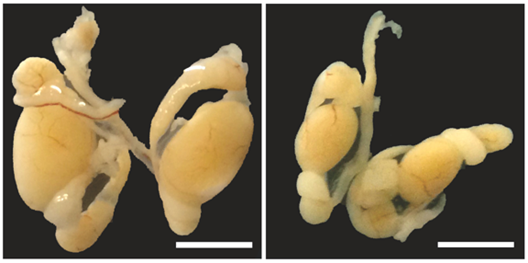CPR and CEHA researchers provide new insights into the DNA repair process
A collaboration between researchers from Novo Nordisk Foundation Center for Protein Research (CPR) and Center for Healthy Aging (CEHA) at the University of Copenhagen has resulted in a study where the protein 'SCAI', which plays a vital role in DNA repair processes in human and mouse cells, has been identified. Identification of this protein and understanding more of its function give hope for more targeted cancer treatment and has implications for fertility.
Studying SCAI we have gained important insights into how cells identify and repair damages to their DNA. We have found that targeting the SCAI protein may increase the killing of cancer cells when combined with other treatments such as radio- or chemo-therapy due to the cancer cells’ inability to repair damages to their DNA. Eventually, these findings may lead to targeted and more effective cancer treatment and help us identify where to focus treatment efforts for targeting cancer cells more effectively.
While much has been learned about the cellular responses to DNA lesions in the past decades, there are still remarkable “black holes” in our understanding of these processes. One area that has been particularly difficult to grasp is how cells manage to detect and repair DSBs in areas of the nucleus with a high degree of compaction and thus a low accessibility to repair proteins – the so-called heterochromatic part of the genome. Our work adds an important new insight into how cells overcome this intrinsic barrier to DNA repair by identifying a new protein that links known upstream signaling mechanisms with the actual DNA repair machinery and facilitates their access to DSBs located in heterochromatin.
DNA damage response – and the function of the SCAI protein
Specifically, we discovered that SCAI promotes the repair of DNA double-stranded breaks (DSBs) in at least two different chromosomal contexts: the first as a specific mediator of DSB repair in regions of the genome with low accessibility (heterochromatin) and the second as a mediator of homologous recombination during meiotic progression in germ cells. Consequently, SCAI is a novel factor required for germ cell development and fertility in male and female mice.
This research is an important mile-stone in our longstanding effort to map the molecular details of the pathways by which human cells repair highly cytotoxic DNA lesions such as DSBs.
Our research can lead to improved cancer treatment
Maintenance of genomic stability is a primary barrier – first line of defense – against cancer development. Conversely, DNA damaging treatments in the form of chemo- and radiotherapy remains the frontline in cancer therapy. Increased knowledge on how human cells deal with cancer-promoting DNA lesions as well as insight into how cancer cells repair their genomes after DNA-damaging therapies hold great promise for the development of future therapies. Exploitation of such knowledge has already led to the development of drugs that exploit cancer-specific defects in DNA repair pathways, and which are used in the clinic today.
While our specific discovery is unlikely to directly lead to new cancer drug-development opportunities, the knowledge gained adds an important new piece to the puzzle of cellular DNA repair, the full elucidation of which holds great potential for future drug discovery.
Consequences for fertility

Testes from 8-week old WT and SCAI-/- mice. Scale bar, 10 mm
Next to our studies of the function of the DSB repair factor SCAI in human cells, we also generated a mouse model deficient for this protein. Remarkably, we found that these mice were strikingly deficient in the germ cell development process due to a failure to repair the DSBs induced during the meiotic recombination process. Thus, male mice had very small testes (see picture below) and produced very little mature sperm cells, and female mice were highly compromised in egg development, resulting in strongly reduced fertility. Decreased fertility is a major societal challenge, and identifying the underlying causes of compromised fertility is an important area of research.
International collaboration led to important discoveries
This work is the result of a truly international endeavour and was carried out in collaboration between a number of research groups in five different countries. Spearheaded by the Mailand, Daniel and Mann groups at CPR, we combined our expertise in DNA damage response research, mouse genetics and proteomics to unravel the identity and functions of a new DSB repair factor. To our help, Germany-based scientists created the SCAI-deleted mouse model, researchers from France and Canada contributed with their expertise in heterochromatin-associated DSB repair assays, and others in Texas contributed their expertise in meiosis.
We and others are convinced that basic discoveries within human DNA repair mechanisms can pave the way for development of novel cancer therapies in the future.
Link to article in Nature Cell Biology, December issue (Late Nov or early Dec): SCAI promotes DNA double-strand break repair in distinct chromosomal contexts
Authors (Authors from CPR in bold):
Rebecca Kring Hansen
Andreas Mund
Sara Lund Poulsen (Formerly CPR)
Maria Sandoval
Karolin Klement
Katerina Tsouroula
Maxim A. X. Tollenaere
Markus Räschle
Rebeca Soria
Stefan Offermanns
Thomas Worzfeld
Robert Grosse
Dominique T. Brandt
Björn Rozell
Matthias Mann
Francesca Cole
Evi Soutoglou
Aaron A. Goodarzi
Simon Bekker-Jensen (currently Center for Healthy Aging, ICMM, KU)
Niels Mailand
Jeremy Daniel
